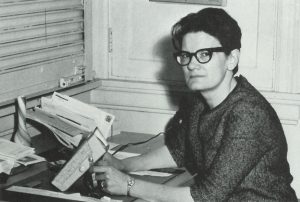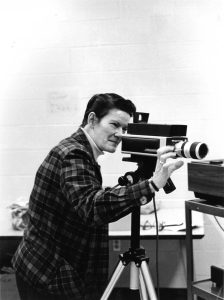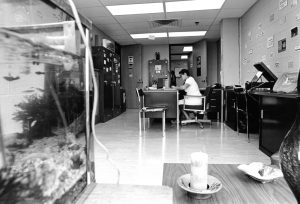By Paul A. Tenkotte, PhD
Special to NKyTribune
Part 73 of our series, “Retrospect and Vista II”: Thomas More College/University, 1971-2021
Cozy, warm, hospitable, caring, compassionate — these are among the many adjectives I use to describe Thomas More University. As a graduate (1982) and a former 22-year fulltime faculty member (1987-2009) of Thomas More University, I experienced the reality of these adjectives firsthand. Most of my memories are associated with dedicated faculty and staff, dozens of whom I and others hold dear in our hearts long after their passing. Among those was a unique person who taught me much about life — Jeanne Pike.
Born on October 16, 1930 in Wheeling, West Virginia, to Charles H. and Eleanor Elizabeth Bauer Pike, Jeanne Pike was the youngest of two children, with an older brother named Charles C. Her father was a fire insurance inspector, and her mother worked as a saleslady at a department store (Jeanne D. Pike, Ancestry.com; 1940 US Census for Martinsburg, WV). Jeanne’s father took her fishing, hiking, and to other activities typically reserved for men at that time. As a result, she grew up with an appreciation of nature, animals, and sports. She attended South Charleston High School in West Virginia, where she was a member of the band. Pike came to Cincinnati to study music at the prestigious College Conservatory of Music (now part of the University of Cincinnati), where she lived in the Girls’ Dormitory as of 1950 (US School Yearbooks, Ancestry.com; 1950 US Census, Cincinnati, OH). She completed her Master of Music thesis, entitled “Contemporary Wood Wind Ensemble Music,” in 1954.

Film Library at Villa Madonna College, Covington, Kentucky, undated. (TMU Archives)
In 1966, Jeanne Pike joined Villa Madonna College Library’s (VMC) audio-visual (AV) department. In 1974, Thomas More’s Vice President for Academic Affairs, James Ebben, awarded her tenure, and in the 1970s, as the college library’s name transitioned to the Learning Resources Center (LRC), Pike’s title evolved to Coordinator of Instructional Media Services (IMS) (Ebben to Pike, November 26, 1974, TMU Archives).
As director of AV/IMS, Jeanne Pike expanded the Film Library that officially began in 1947 at Villa Madonna College (VMC) in Covington. She became Audio Visual Director at VMC in 1966, when that department was housed in Columbus Hall on Madison Avenue. She developed a working relationship with the largest AV collection in the region, housed at the Public Library of Cincinnati and Hamilton County (PLCH) in downtown Cincinnati. In a memo sent to VMC chairs and faculty in August 1966, she proudly noted that PCLH films could be borrowed at a “nominal insurance fee of ½¢ per minute of black and white film and 1¢ per minute of color film; e.g. a 10 minute black and white film costs 5¢ and in color, 10¢.” And in case faculty were concerned about the cost, Pike clearly noted that “A receipt will be given to you upon payment at the Films and Recordings Center and, if arrangements have been made with the chairman of your department, the money will be refunded to you” (Pike, memo to faculty, August 1966, TMU Archives).
Pike also oversaw a media subscription service at VMC/TMC, whereby local Catholic and public elementary, middle, and high schools — as well as St. Pius X Seminary and the College of Mt. St. Joseph — could borrow films and filmstrips from the Thomas More collection. It was the “second film library in the country to serve diocesan schools” (Sr. M. Irmina Saelinger, Retrospect and Vista: The First Fifty Years of Thomas More College, formerly Villa Madonna College, p. 30). Like everything that Pike supervised, it was a fair and judicious subscription program, with lower annual costs for schools of 100 students or less ($35), and slowly increasing rates — in a graduated scale — to those enrolling 2,501 to 3,000 ($400). For schools with more than 3,000 students, the rate was “50 additional for each succeeding 500 enrollment” (“To the Parochial Schools of the Diocese of Covington,” 1974, TMU Archives). Of course, the collection was also available to Thomas More’s faculty, staff, and students.
By August 1979, the college’s fiscal condition was adversely affecting the purchase of new films and videotapes. Pike alerted President Robert Giroux and Library Director Arthur Taylor of the situation, including complaints from member schools. Of immediate concern to her was the fact that the media subscription fees were being diverted to the college’s general fund, and not to “the operating budget of the film services.” Nonetheless, in a heroic effort to maintain the collection that the institution owned, Pike spent “almost $300 out of the Library funds to get the 1,000 plus titles cleaned and fixed for the coming year.” Yet, a basic problem of obsolescence remained, as Pike succinctly expressed, “Many science films are out of date.” As a result, the number of schools subscribing to the service steadily declined from a height of 30 in 1972 to only 18 in the academic year 1978–1979, and by 1979–1980, to merely 10 (Taylor to Giroux, March 16, 1979, TMU Archives; “LRC Film Library Services Meeting,” January 1980, TMU Archives).
Pike pleaded with the administration to restore the subscription money to its proper use. “Two thousand dollars will buy about six films,” she noted. If this were not possible, Pike felt it was “only fair . . . that we should dissolve the film service immediately” to subscriber schools, and to “attend to our own ‘shop.’” Fortunately, the college was already a member of the new Greater Cincinnati Library Consortium’s (GCLC) Films Library, which could, as Pike explained, “supply us with many films the [Thomas More] faculty currently need” (Pike to Giroux and Taylor, August 24, 1979, TMU Archives).

Jeanne Pike at Villa Madonna College, Covington, Kentucky, 1967. (TMU Archives)
Fr. Joseph Brink, interim Thomas More president, addressed the subscription film library problem in 1981 with some encouragement. With the donation of “some 400 films with a value of between $20,000 and $40,000” by Cincinnati Bell Telephone and a rise in subscription memberships in 1980–1981, Brink suggested retaining the media lending library for the time being (Brink to Taylor, June 22, 1981, TMU Archives).
Despite fiscal constraints, Pike brought the college’s audio-visual department into the fast-changing technological world of the late-twentieth century. By 1979, the permanent college collection included 1,009 16mm films, 572 8mm films, 4,164 filmstrips, and 240 slides (“Current Statistics, TMC Learning Resources Center Film Service,” TMU Archives). By attending seminars regionally and nationwide, Pike remained innovative. Over the years, she provided many varied services to students, faculty, and staff, including: acquiring and maintaining thousands of media in many forms (films; filmstrips; videotapes; phonograph records; audio cassettes; slides; etc.); videotaping and editing; making slides and transparencies; laminating and dry mounting materials; providing projectors and televisions and other equipment for classroom instruction; duplicating audio- and video-cassettes; and holding faculty instructional seminars, such as “Simple Production Techniques You Can Do Yourself,” and “Video and Slide/Tape Presentations” (undated Pike brochure draft, TMU Archives; Pike memo, “Equipment/services,” Fall 1990, TMU Archives).
In the mid-1980s, Jeanne Pike purchased an Osbourne computer, in an era when desktop computers were just beginning to attract attention. She used it to update the college’s media catalog. By 1990, however, she was in need of a more reliable desktop to “get out a new film catalog, set up my inventory, write grant proposals and reports, and to up-date the catalogs as needed” (Pike to Esselman, Rebel Boosters Club, January 19, 1990, TMU Archives). And In 1992, as she neared retirement, Pike announced the creation of the first classrooms at Thomas More specially equipped with permanent media equipment (Pike, Memo to faculty, August 19, 1992, TMU Archives).
Jeanne Pike had an outgoing personality. Her homespun speech and mannerisms, always truthful and kind, sometimes belied the depth and breadth of her intellect and knowledge. As an undergraduate student at Thomas More, I recall one week when Sr. Mary Philip Trauth had to travel to give a presentation and entrusted her Traditional Russia class to Jeanne Pike. The week prior, Sr. Mary Philip had confidently stated that we would be in good hands, as “Miss Pike” was going to show an excellent classic movie by the noted Russian film director, Sergei Eisenstein. The following week, an enthusiastic Jeanne Pike offered a historical background to the film, and then turned on the projector. She must have read the chagrin on our faces when we realized the tediousness of a “silent film.” I recall how seamlessly Pike recovered and improvised, as she stopped the film at different parts, and explained the importance of cinematography in silent films, as well as details about the director and the film’s acting.
It was no wonder to me that Sr. Mary Philip and faculty of the college appreciated the full range of Pike’s knowledge, as well as her ability to make film come alive for decades of college students.
A completely different segment of Pike’s expertise involved athletics, exemplified by her management of the college’s unofficial and low-stakes, faculty/staff Sunday/Monday NFL football pool.
Perhaps not surprisingly, she also loved card playing.

Jeanne Pike focusing an early yet cutting-edge Magnavox videotape recording camera, circa mid-1970s, Thomas More College. (TMU Archives)
I spent many lunches with Jeanne Pike and colleagues in Seiler Commons on the Crestview Hills campus. She had a remarkable gift for storytelling, as well as a very self-effacing sense of humor. For instance, in 1968—when the Hong Kong Flu was circulating across the nation — Cincinnati Enquirer reporter Sally Wright asked a number of people the question, “What do you do for the flu?” Jeanne Pike responded, “Well, I don’t plan on getting it. But if I did, I would take a good stiff shot [of bourbon] and go to bed. If that doesn’t do it, try another one. It’s good for snake bite, bunions, anything. Even if you don’t feel better, it doesn’t bother you as much” (“Opinionnaire by Sally Wright,” Cincinnati Enquirer, November 29, 1968, p. 6).
Jeanne Pike occupied a commodious office on the first floor (we called it the “basement”) of the Thomas More library in Crestview Hills. Films, videotapes, and projectors of many makes and models surrounded her, as did her aquarium. Like many faculty and students, I never missed an opportunity to visit her when she was in her office. She was always happy to see everyone, to greet them with a smile, and to tell a joke or share a funny story.
A trained musician, Pike also became a talented artist in her later life. She started enrolling in art classes with Thomas More art professor, Darrell Brothers, in the 1990s. (See also the NKyTribune history column.) After her retirement in 1993, she remained engaged at the campus, continuing art classes under the tutelage of professors Rebecca Bilbo, Barbara Rauf, and Walter Driesbach. She also enjoyed traveling with members of the Art department on their student trips to New York City, and in 2002, to Spain with professors Bilbo and Maria “Cari” Garriga (Tenkotte, telephone conversation with Dr. Rebecca Bilbo, November 26, 2022). Pike even enrolled in my History of American Architecture class, where she was (as always) a stellar and enthusiastic participant, and loved partaking in the architectural field trips.
Pike never learned to drive, and she remained single throughout her life. For many years, she lived in an apartment complex in Fort Mitchell, Kentucky, across the hall from William Guilfoyle, a professor of Education at Thomas More. (See also this NKyTribune history column.) In her later years, Jeanne bought a home on Thomas Street in Erlanger. When her friend and colleague, Biology professor Sr. Mary Laurence Budde, developed mobility issues, compassionate Pike had a ramp constructed to her front doorway so that her friend could still visit. (See also this NKyTribune history column.)

Jeanne Pike in her office, TMC Library, 1977. (TMU Archives)
Following Pike’s retirement in 1993, Thomas More theater alumnus Matt Mattingly became coordinator of the IMS department. In 1999, the department moved to the administration building under the coordination of Ryan Zech.
Jeanne Pike died of cancer at the age of 79 on May 14, 2010. She donated her body to the University of Cincinnati College of Medicine, and her cremains were buried in Spring Grove Cemetery in Cincinnati (Jeanne D. Pike, Ancestry.com). She bequeathed more than 600 art books and 130 artworks to the college’s Art department (William Croyle, “Artist’s Work Will Benefit her Thomas More ‘family,’” Cincinnati Enquirer, June 29, 2011).
To all those students and faculty who borrowed a film or videotape, laminated their presentations, or simply enjoyed her sense of humor, Jeanne Pike was a mentor, friend, colleague, and confidante.
We want to learn more about the history of your business, church, school, or organization in our region (Cincinnati, Northern Kentucky, and along the Ohio River). If you would like to share your rich history with others, please contact the editor of “Our Rich History,” Paul A. Tenkotte, at tenkottep@nku.edu. Paul A. Tenkotte, PhD is Professor of History and Gender Studies at Northern Kentucky University (NKU) and the author of many books and articles.
























